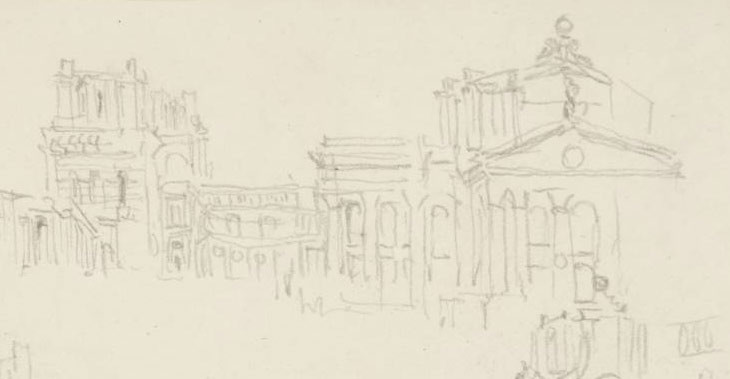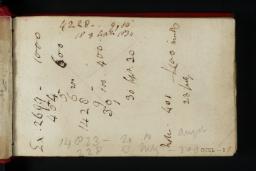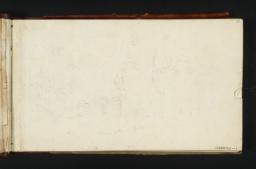Tour of the English Midlands 1830

From the entry
In the late summer of 1830, Turner toured the English Midlands, focusing on Oxfordshire, Warwickshire, the area now covered by the West Midlands metropolitan county (centred on Birmingham), Staffordshire, Leicestershire and Northamptonshire. He was in search particularly of fresh material for his series of watercolours showing Picturesque Views in England and Wales. He had not focused on the Midlands since 1794, when en route and returning from Wales he recorded sites in Northamptonshire, Warwickshire, Shropshire, Cheshire, Staffordshire, Derbyshire, Nottinghamshire, Lincolnshire and Cambridgeshire. There are only a few subjects in common with those of 1830: Northampton, Warwick, and Lichfield; see Andrew Wilton’s entries for the 1794 sketches and related works in the ‘Midlands 1794–1802’ section of the present catalogue. As A.J. Finberg noted, political disturbances on the Continent in 1830 (including revolutions in July in France and in August in Belgium) precluded Turner’s ...
Kenilworth Sketchbook principally 1830
D21975–D22012, D22014–D22150, D41045–D41046, D41540
Turner Bequest CCXXXVIII 1–90a
D21975–D22012, D22014–D22150, D41045–D41046, D41540
Turner Bequest CCXXXVIII 1–90a
Birmingham and Coventry Sketchbook principally 1830
D22323–D22462, D41056–D41057
Turner Bequest CCXL 1–72a
D22323–D22462, D41056–D41057
Turner Bequest CCXL 1–72a
References
In the late summer of 1830, Turner toured the English Midlands, focusing on Oxfordshire, Warwickshire, the area now covered by the West Midlands metropolitan county (centred on Birmingham), Staffordshire, Leicestershire and Northamptonshire. He was in search particularly of fresh material for his series of watercolours showing Picturesque Views in England and Wales. He had not focused on the Midlands since 1794, when en route and returning from Wales he recorded sites in Northamptonshire, Warwickshire, Shropshire, Cheshire, Staffordshire, Derbyshire, Nottinghamshire, Lincolnshire and Cambridgeshire. There are only a few subjects in common with those of 1830: Northampton, Warwick, and Lichfield; see Andrew Wilton’s entries for the 1794 sketches and related works in the ‘Midlands 1794–1802’ section of the present catalogue.
As A.J. Finberg noted, political disturbances on the Continent in 1830 (including revolutions in July in France and in August in Belgium) precluded Turner’s travelling to France or Italy that year. (Greece had been was another possible destination.1) He suggested that Turner began ‘late in August, when the General Election was over’ and was back in London for the Royal Academy General Assembly of 1 November.2 James Hamilton suggests ‘a specific connection, as yet undiscovered’3 between the September 1829 general exhibition at the new premises of the Birmingham Society of Arts, in which six England and Wales watercolours by Turner were shown alongside many other works by London artists,4 and Turner’s travelling to the area in 1830.
Finberg posited that three sketchbooks, Kenilworth (Tate; Turner Bequest CCXXXVIII), Worcester and Shrewsbury (Tate; Turner Bequest CCXXXIX) and Birmingham and Coventry (Tate; Turner Bequest CCXL) were used on this single tour.5 In fact, the Worcester and Shrewsbury sketchbook appears rather to have been used for a completely separate itinerary in 1831, encompassing more northerly parts of the Midlands including the Peak District as a preamble to Turner’s Scottish expedition. It is catalogued by the present author in a separate section of its own, while the subsequent Walter Scott-related tour of the North of England and Scotland has been catalogued by Thomas Ardill as ‘Scotland 1831’. Assuming that Turner had been sketching at Castleton in the Derbyshire part of the Peak in the summer of 1830 – for which see the 1831 Worcester and Shrewsbury sketchbook – Finberg quoted Turner’s letter of 7 November 1830 to his artist friend James Holworthy (1781–1841) at Hathersage, about five miles from Castleton: ‘I could not get as far north as your worship’s residence.’6 This would by rather disingenuous of Turner had he been so close in 1830, but the most northerly identified subject sketched that year, Ashby-de-la-Zouch, Leicestershire, lies just outside Derbyshire, some forty miles south of Hathersage as the crow flies, making his excuse for being ‘delinquent with [Holworthy’s] invitations’7 understandable, while confirming his recent presence further south in the Midlands.
Setting aside the subsequent Worcester and Shrewsbury subjects Finberg lists, he gives the following as Kenilworth sketchbook subjects: ‘Oxford, Warwick, Kenilworth, Tamworth, Ashby-de-la-Zouch, Lichfield, Birmingham, and Dudley’, adding Coventry as exclusive to the Birmingham and Coventry sketchbook;8 in fact there is a single Coventry view in the Kenilworth book. James Hamilton states that the latter sketchbook ‘reveals the route taken by Turner’: Oxford, Blenheim Palace, Leicester, Ashby-de-la-Zouch, Kenilworth, Warwick, Lichfield, Tamworth and Dudley.9 Hamilton’s suggested itinerary represents something of a zigzag on the map. An alternative route, by no means definitive but representing a roughly clockwise circuit from Coventry onwards, is suggested here:
Oxfordshire: Oxford, Woodstock and Blenheim Palace; Warwickshire: Coventry, Kenilworth, Guy’s Cliffe, Warwick, Wroxall; West Midlands: Solihull, Birmingham (formerly Warwickshire); Dudley (formerly Worcestershire); Staffordshire: Lichfield, Hopwas, Tamworth; Leicestershire: Ashby-de-la-Zouch, Leicester; Northamptonshire: Northampton and Hardingstone
Of these subjects, Birmingham, Coventry, Dudley, Lichfield, Tamworth and Leicester are common to the two sketchbooks, the broader contents of which are discussed in their respective introductions. By far the largest number of sketches are devoted to Dudley, a rapidly expanding industrial town (albeit with many views of its ruined castle and priory in relatively rural surroundings), but there are many more traditionally ‘picturesque’ studies of castles, country houses, churches and ruins. There is also a substantial sequence of sketches around Virginia Water in Surrey at the end of the Kenilworth sketchbook, possibly made no later than as 1827. Another sequence, at the end of the Birmingham and Coventry book, shows the new bridge on the Thames at Hammersmith, and may also date from about 1827, suggesting that Turner had left the rest of each sketchbook fallow before taking them both up again in 1830.
The ninety-six engravings comprising the England and Wales series were issued between 1827 and 1838. The principal list of nine Midlands subjects below, published between 1832 and 1835, is given in order of the standard Rawlinson engravings and Wilton watercolours catalogues.10 References are given to engravings in the Tate Collection and to the most directly related studies in the two sketchbooks used on this tour, Kenilworth (Turner Bequest CCXXXVIII) and Birmingham and Coventry (CCXL):
Blenheim, Oxfordshire, c.1832 (Birmingham Museum and Art Gallery); engraved 1833: Tate T04599, T04600, T06101.15 Sketches: Tate D21993–D21995 (Turner Bequest CCXXXVIII 11a–12, 12a)
Coventry, Warwickshire, c.1832 (British Museum, London); engraved 1833: Tate T06105.16 Sketches: Tate D22368–D22371 (Turner Bequest CCXL 25a–26, 26a–27)
As Andrew Wilton as observed, there is a lack of direct studies of human activity in the two 1830 sketchbooks,20 and Turner used his customary combination of memory and imagination to populate these designs. Two fully completed England and Wales-type watercolours stemming from the tour were not engraved:
A further Midlands watercolour design Worcester, Worcestershire, of about 1834 (British Museum, London), was engraved for England and Wales in 1835 (Tate impression: T06117),23 based on drawings in the 1831 Worcester and Shrewsbury sketchbook (Tate D22300, D22304, D22305; Turner Bequest CCXXXIX 80a, 82a–83). The watercolour of Nottingham, Nottinghamshire, probably of 1832 (Nottingham City Museums and Galleries),24 engraved for England and Wales in 1833 (no Tate impression)25 and issued at the same time as Coventry, Warwickshire, was based on a 1790s design, as Turner did not travel to Nottingham in the 1830s. For a series of ‘colour beginnings’ of Oxford’s High Street, possibly working towards an England and Wales design, see under the related drawing in the Kenilworth sketchbook (Tate D21976; Turner Bequest CCXXXVIII 1a).
The author is particularly grateful for the assistance of Dr Bernard Richards (Emeritus Fellow, Brasenose College, Oxford), who fortuitously contacted Tate while the present tour was being catalogued. Dr Richards enthusiastically shared his unpublished Turner research, informed by local knowledge of Dudley and Birmingham subjects in particular,26 many of which have been identified or confirmed here with his help as noted in individual entries.
See ibid., pp.143–7, 196, 199 notes 8, 10; see also Eric Shanes, Turner’s Picturesque Views in England and Wales 1825–1838, London 1979, p.157.
Finberg 1961, p.323; 1830 dating followed for all three sketchbooks by Wilton 1975, p.124, 1979, p.191 note 18, 1987, p.168 and 2006, p.238.
Finberg 1961, p.323; see also John Gage, Collected Correspondence of J.M.W. Turner with an Early Diary and a Memoir by George Jones, Oxford 1980, p.139 letter no.164; for more on Holworthy see Luke Herrmann, ‘[Reviews: Books:] Collected Correspondence of J.M.W. Turner’, Turner Studies, vol.1, no.2, [Winter 1981], p.47, where the Worcester and Shrewsbury sketchbook is dated 1830.
W[illiam] G[eorge] Rawlinson, The Engraved Work of J.M.W. Turner, R.A., vol.I, London 1908, pp.xlvii–l, xciv–xcvi, 117–69 nos. 209–304; Wilton 1979, pp.391–403 nos.785–880, and ibid., pp.403–4 nos.881–895 for related designs; see also Eric Shanes, ‘England and Wales, Picturesque Views in’ in Evelyn Joll, Martin Butlin and Luke Herrmann (eds.), The Oxford Companion to J.M.W. Turner, Oxford 2001, pp.87–9.
How to cite
Matthew Imms, ‘Tour of the English Midlands 1830’, August 2013, in David Blayney Brown (ed.), J.M.W. Turner: Sketchbooks, Drawings and Watercolours, Tate Research Publication, September 2014, https://www


